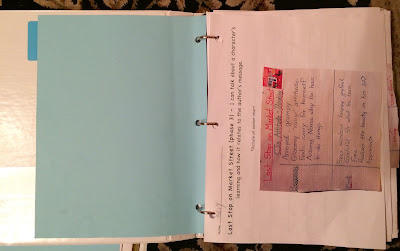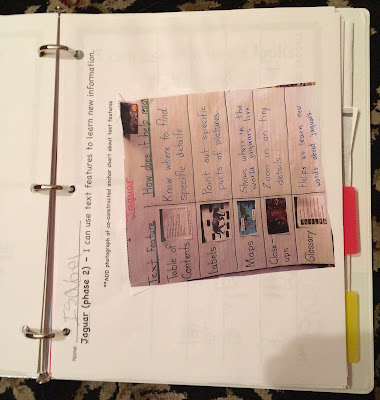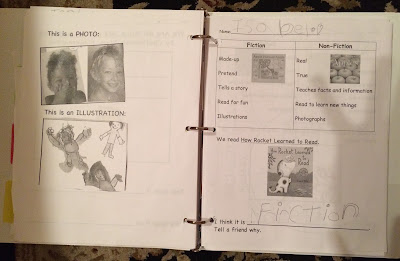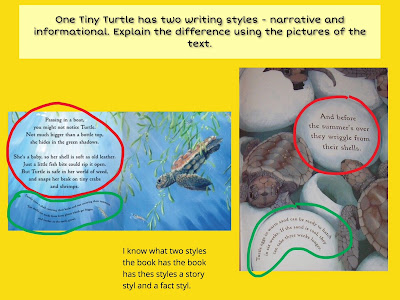Thoughtful Logs - Thoughts, ideas, and learning worth remembering in reading and writing.
What are thoughtful logs? A tool readers and writers use to help them grow as learners.
Why are they important?
- They make our learning visible
- They deepen our understanding of what we are reading/writing
- They connect our learning in reading and writing
Oh the joys of organizing a thoughtful log in kindergarten! I have to admit I spent a lot of time stressing about the best method of organization for our thoughtful logs. Kindergarten students are special in this regard because they don't quite understand sophisticated organizational concepts yet, nor are they able to maneuver between pages/sections very easily. I thought about a composition notebook like the majority of my school has. But, the lines were so small, and finding where we left off in the notebook was tricky. So, this led me to the idea of using a 3 ring binder. I figured that our entries could be copied onto paper with spaces and lines appropriate for kindergarten. Then, students could add their papers into the 3 ring binder. This isn't the best solution as we REALLY have to teach students how to use the binder carefully (without dumping pages, getting all the holes lined up, etc.). This is an ongoing teaching process. With upper grade levels, I would definitely use a composition notebook, especially because they are using the thoughtful log more independently as a tool during their independent reading. At the kindergarten level I'm doing a lot of scaffolding, so this works for us.
Here's some examples of what my entries look like. Notice that I print off a color copy of the anchor chart that we created during the lesson. Students cut it out and glue it onto the front of their entry. They can refer back to this anchor chart as they respond. Also, notice that I add the phase number. This is only for my reference. Once I had several different entries printed, and I gave the kids the entry for the wrong phase. Now, if I have the phase number on the entry, it keeps me organized! Don't forget to "pre" 3 hole punch the copies. My copy machine can do this automatically, so it's easy!
Anchor chart as a class "scaffold"
The anchor chart is copied and pasted onto the thoughtful log entry.
On the back side, students respond to my question or prompt.
When finished, students put the paper into their 3 ring binder thoughtful log under the correct tab depending on the type of learning: My Thinking, Strategies, Language, and Genre.
My Thinking: This is where students share their thinking and respond to text using evidence. This is the largest section of the thoughtful log as it houses most of our thinking regarding the books we read. Students are thinking and reflecting on reading in this section. There are often "prompts" to ensure high levels of thinking. We also emphasize using evidence from text.
Here are a few examples:
Strategies: Students are learning and using strategies in this section. In kindergarten this can include decoding strategies, since this is a major part of our reading strategy work, but it also includes comprehension strategies such as asking questions, making connections, inferencing, synthesizing, predicting, summarizing, etc. This section is often full of anchor charts that serve as a resource and scaffold for student thinking. Ideally, students refer back to this section during independent reading to access these strategies.
Decoding Strategies:
Language: This section used to be called "powerful words and phrases." I really liked this name, but now we call it "language" because that encompasses more of the deeper workings of the words and structures within the text. I also combined my language section with word work this past year. I won't do that again. It got too confusing for kids. I will have to find another avenue to house word work. The language section helps students understand how words and phrases help them visualize and deepen understanding as readers and how they can apply powerful word choice to their own writing.
Comparisons - This is an example of a language structure that authors use for effect. We study how authors use a comparison phrase to give readers a better picture of what they mean.
Vocabulary/Word Choice:
Genre: This section is probably my least utilized section in kindergarten, simply because our genre study isn't as broad and/or deep as in other grade levels. I do want to work on getting better at this! This section serves as a resource and scaffold for student thinking within specific genres. Knowing how a genre is typically set up aids a reader in knowing how to read a text and what to look for. Knowing the features of a genre is helpful in analyzing text. In kindergarten, we tend to stick to fiction vs. nonfiction. However, this year we delved a little into biographies and folktales. We also explored the difference between nonfiction and narrative nonfiction in
One Tiny Turtle. My hope is to expand on this.
A little biography introduction:
I hope this was a little helpful in learning how I set up thoughtful logs. Of course I do have the
Digital Thoughtful Log on the iPad as another format. What really ends up happening in my classroom is that students work on the paper/pencil thoughtful logs with my support during language workshop. I feel that as kindergarten students, they still need the support with the mechanics of learning how to write. During independent reading/small group work time, students work on their digital thoughtful logs because there is more independence built in with the technology component - students can record thinking or take/draw pictures to show understanding on the iPad. I like this "balance" between paper/pencil and digital thoughtful logs because kids get exposure to both formats.

























































